Seed Lot Sampling - NCR Bulletin 403
Seed Lot Sampling
North Central Regional Extension Publication 403, July 1991
A. D. Knapp, agronomist
T. J. Gutormson, agronomist
M.K. Misra, agricultural engineer
Sponsored by the Extension Services of Iowa, Minnesota, Missouri, North Dakota, Ohio and Wisconsin in cooperation with ESUSDA.
Careful sampling of a seed lot is an important step in obtaining a sample which accurately reflects the characteristics of the seed lot. Aside from carefully controlled production and conditioning practices, painstaking sampling is actually the first step in assuring accuracy and precision in seed testing.
The purpose of seed testing is to obtain information regarding the planting value of seed in any particular seed lot. For testing to be meaningful, seed samples must be properly collected. Seed tests often generate information which must, by law, appear on the seed label and/or is required for obtaining a phytosanitary certificate. Both the seed producer and the buyer rely on accurate laboratory information. Seed testing laboratories therefore must have modern equipment and well trained analysts. However, seed lot sampling may be beyond the control of the seed analyst conducting tests on the submitted sample. And if the submitted sample is not representative of the seed lot, the laboratory analyses cannot accurately reflect the planting value of that seed.
The Seed Lot
A seed lot can be defined as a quantity of seed with every portion or every bag uniform within permitted tolerances as to percentage of pure seed, inert matter, other crop seed, germination and dormant seed, weed seed, and rate of occurrence of noxious weed seeds. A quantity of seed which is not uniform within permitted representative tolerances should not be classified as a seed lot. Any variation should be reduced by further conditioning, by mixing, or by separating the quantity in question into two or more uniform lots.
The physical and/or physiological uniformity of a given amount of seed can be affected by a number of factors including: seed harvested from different fields or at different times; exposure of seed to different environments during production; damage done by frost (reduced seed quality in low lying areas of the field); dense weed patches in some areas of a field (degraded seed quality); or moisture migration patterns and heating within a seed bin which has damaged certain portions of stored seed. Some plant species which have indeterminate growth habits produce seeds which are naturally variable in seed quality.
Sampling
Figure 1. Probes
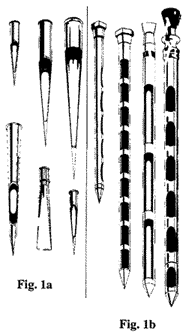
Figure 1a. Probes which may provide samples which do not represent the lot.
Figure 1b. Probes which provide a representative sample.
Sampling of free flowing seed is usually accomplished with various probes and triers (Figure 1a and lb). Short probes (Figure 1a) are not recommended for sampling since they do not access all areas of the bag. Proper sampling of bagged seed is accomplished by probing the horizontal bag diagonally from corner to corner (Figure 2). The trier should be long enough to sample along the entire diagonal distance of the bag. It should be inserted with slots closed and facing down. Upon full insertion into the bag, the slots should be rotated upwards to dislodge any seed which may have been carried along with the trier sections as the trier was inserted, and the slots opened.
Figure 2. Recommended method of probing bags of seed.
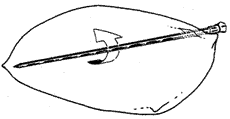
Bags are usually sampled according to the intensity recommended in the Association of Official Seed Analysts, "Rules for Testing Seeds." These guidelines recommend that 5 bags, plus 10 percent of the remaining bags should be sampled (Table 1) . A minimum of six bags should be sampled and it is usually not necessary to sample more than 30 bags. Larger seed lots destined for overseas markets may require more intensive sampling according to the International Seed Testing Association Rules.
Table 1: Recommended sampling intensity for seed in bags.
|
1 |
to |
6......* |
95 |
to |
104.....15 |
195 |
to |
204......25 |
|
7 |
to |
14......6 |
105 |
to |
114.....16 |
205 |
to |
214......26 |
|
15 |
to |
24......7 |
115 |
to |
124.....17 |
215 |
to |
224......27 |
|
25 |
to |
34......8 |
125 |
to |
134.....18 |
225 |
to |
234......28 |
|
35 |
to |
44......9 |
135 |
to |
144.....19 |
235 |
to |
244......29 |
|
45 |
to |
54.....10 |
145 |
to |
154.....20 |
245 |
to |
254......30 |
|
55 |
to |
64.....11 |
155 |
to |
164.....21 |
255 |
or |
more. 30 |
|
65 |
to |
74.....12 |
165 |
to |
174.....22 |
|||
|
75 |
to |
84.....13 |
175 |
to |
184.....23 |
|||
|
85 |
to |
94.....14 |
185 |
to |
194.....24 |
* For lots of 1 to 6 bags, sample each bag and take a total of at least 5 cores or handfuls.
Most references indicate that when sampling seed in bulk, five to seven probes must be made. These probes (Figure 3) should represent as many locations in the bulk as possible.
Figure 3. Bulk sampling
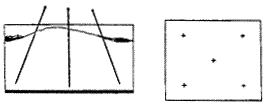
Non free flowing seeds should be sampled by hand as follows; the hand is inserted into the bag with the fist open Figure 4). Upon reaching the appropriate location, the hand is closed (Figure 4) and a sample taken. Every effort must be made to obtain samples from various
locations in the bag.
Figure 4. Hand sampling
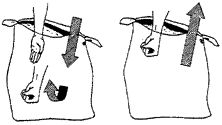
Automatic Sampling
Automatic samplers are those placed in a conditioning line to take samples from time to time while the seed is flowing. Sampling intervals, as well as the quantity of seed taken with each sample, are usually adjustable. Automatic samplers may be "homemade" but are also available from a number of commercial sources. The commercial samplers are usually motor driven and can be installed in pipes, spouts, hoppers, chutes, and bagging bins. Automatic samplers which draw a sample from across the entire flow of the seed and which close tightly following sampling, most accurately sample the seed lot.
There are two locations where a homemade automatic sampler may be placed during bagging. Figure 5 shows an installation where the sampler is placed in a hopper bottom bagging bin. The sampler consists of two concentric tubes with open slots. When the tubes are rotated, matching up the slots, the seeds flow out. The volume of the flow can be controlled by a change in the area of slot presented to the seed flow.
Figure 5. Automatic sampler installed in bagging bin
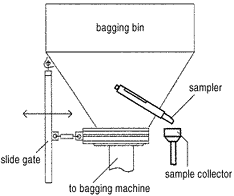
Another automatic sampler installation point is in the bagging machine itself (Figure 6). This sampler design is similar to the one just described. As each bag is filled, a few seeds dribble
through the sampler and are collected in a container. This installation's advantage is that the sampler is more accessible for cleaning and adjustments between seed lots.
Figure 6. Automatic sampler installed in bagging machine.
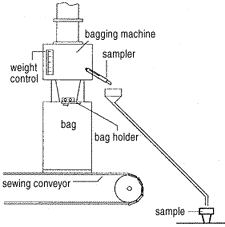
Regardless of the sampling protocol, all individual probes should be evaluated to determine whether or not there is any variation within the seed lot. If there is no apparent variation, the individual probes should be combined. The combined individual probes should be thoroughly mixed and a sample of the combined probes submitted to the Seed Testing Laboratory.
Ideally, this sample should be obtained through the use of mechanical dividers to ensure that a truly random sample is collected from the mixture of the seeds that came from the individual probes.
For further information, refer to "Handbook for Seed Inspectors," Association of American Seed Control Officials. and, Gregg, Bill. "A Good Seed Sample: the Real Picture of Seed Quality, Circ. P32. Coop. Ext. Serv., Auburn University—from which some of this discussion was derived.
In cooperation with NCR Educational Materials Project.
Issued in furtherance of Cooperative Extension work, Acts of Congress of May and June 30, 1914, in cooperation with the U.S. Department of Agriculture and Cooperative Extension Services of Illinois, Indiana, Iowa, Michigan, Minnesota, Missouri, Nebraska, North Dakota, Ohio, South Dakota, and Wisconsin. Robert M. Anderson, Vice Provost for Extension, Iowa State University, Ames, Iowa 50011.
Programs and activities of the Cooperative Extension Service are available to all potential clientele without regard to race, color, sex, national origin, religion, age, or handicap.
For copies of this publication, contact the universities listed as sponsors.
County Commissions, North Dakota State University and U.S. Department of Agriculture cooperating. North Dakota State University does not discriminate on the basis of race, color, national origin, religion, sex, gender identity, disability, age, status as a U.S. veteran, sexual orientation, marital status, or public assistance status. Direct inquiries to the Vice President for Equity, Diversity and Global Outreach, 205 Old Main, (701) 231-7708. This publication will be made available in alternative formats for people with disabilities upon request, 701 231- 7881.
Information for Prospective Students
NDSU is an equal opportunity institution
This information may be photocopied for noncommercial, educational purposes in its entirety with no changes.
Requests to use any portion of the document should be sent to NDSU.permission@ndsu.edu.
North Dakota State University Agriculture and University Extension Dept. 7070, Morrill 7, P.O. Box 6050, Fargo, ND 58108-6050

